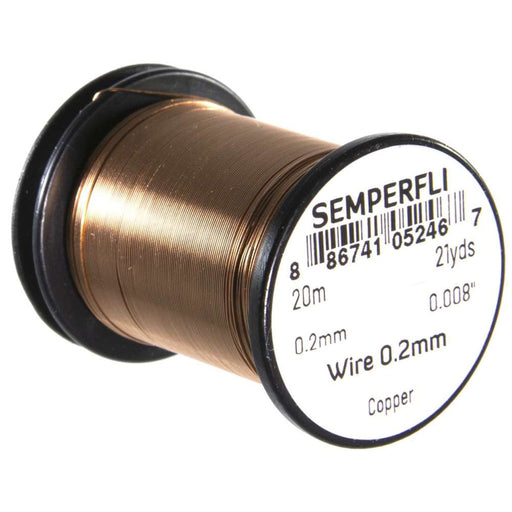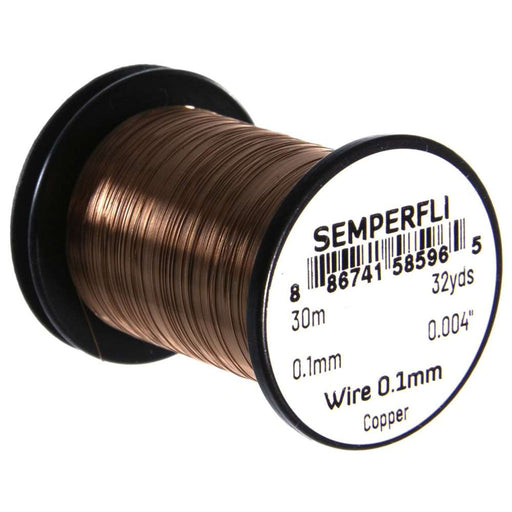
Fly Tying | Thread/Wire
You can't tie flies without threads and where would we be without wire.
We stock a range of threads form Semperfli so that you can tie the tiniest gnat on a size 20 hook, or spin deer hair with confidence on a 2/0 predator fly. You'll need wire to build ribs, add weight and occasionally fix the blown circuit in your old home (although we don't recommend that unless your a licensed electrician and a fly fishing bum).
Click here to read more...
WHAT IS FLY TYING THREAD?
Fly tying thread is a specialized, thin, and strong thread used to construct and secure various materials onto a fly hook. It serves as the foundation for building flies, binding materials like feathers, fur, and synthetic fibres together to create lifelike imitations of insects, baitfish, or other prey that fish feed on. The thread also helps form the body of the fly, create heads, and build up bulk where needed, playing a critical role in both the appearance and durability of the finished fly.
THINGS TO CONSIDER WHEN CHOOSING A THREAD
When choosing fly tying thread, several factors should be considered to ensure it suits the specific fly you're tying. The material of the thread is important, with options like nylon, polyester, and gel-spun polyethylene (GSP) offering different levels of strength, stretch, and durability. Nylon threads are common for general-purpose tying due to their good stretch and ease of use, while polyester threads are slightly stronger and more abrasion-resistant. GSP threads are extremely strong for their diameter and are ideal for tying large, heavy flies where maximum strength is required.
Another consideration is the flatness or roundness of the thread. Flat threads can be easily split and laid down smoothly on the hook shank, which is ideal for creating smooth, even bodies. Round threads are better for tying smaller flies where a finer finish is desired. Additionally, the colour of the thread is crucial, as it can either blend in with the fly materials or provide contrast for specific patterns. Lastly, the thread diameter or thickness should match the size of the fly being tied; finer threads are used for smaller flies, while thicker threads are suitable for larger patterns.
UNDERSTANDING THREAD SIZES
Thread size in fly tying is typically measured using two different systems: the Aught rating and the Denier system.
Aught Rating: The Aught (/) rating is an older, somewhat traditional system used to describe the fineness of fly tying thread. In this system, a lower number signifies a finer thread, while a higher number indicates a thicker thread. For example, a 12/0 thread is much finer than an 8/0 thread.
However, the Aught system can be inconsistent across different manufacturers because there is no strict standardization. This means that a 12/0 thread from one brand might not be exactly the same thickness as a 12/0 thread from another brand. Despite its inconsistencies, the Aught system remains widely used, especially among those who have been fly tying for many years and are accustomed to its conventions.
Denier: The denier system offers a more standardized and precise way of measuring thread thickness. It measures the weight (in grams) of 9,000 meters of the thread. A lower denier number indicates a finer, lighter thread, while a higher denier number points to a thicker, stronger thread. For example, a 70-denier thread is finer and lighter than a 140-denier thread. This system is more consistent across different manufacturers, making it a preferred choice for many modern fly tiers.
Aught to Denier Conversion: While there isn’t a perfect one-to-one conversion between the Aught and denier systems due to the lack of standardization in the Aught system, some general equivalents can help with understanding. For example:
- A 6/0 thread typically corresponds to around 130-140 denier.
- An 8/0 thread is generally equivalent to about 70-80 denier.
- A 12/0 thread might equate to approximately 50-60 denier.
FLY TYING WIRE
Fly tying wire is a thin, flexible wire used in fly tying to add weight, create ribbing, and enhance the durability of flies. It comes in various sizes and colours, allowing tiers to match or contrast the materials used in the fly. The wire is often wrapped around the hook shank to create a segmented, ribbed appearance that mimics the body of insects like nymphs or to add weight to help the fly sink more quickly. Fly tying wire can also be used to secure materials tightly and prevent them from unraveling, contributing to the overall strength and longevity of the fly.
NEED HELP CHOOSING THREAD OR WIRE? CONTACT US TODAYIf you would appreciate some additional advice. Simply get in touch with our friendly sales team – they’re always up for a chat. You can contact us by calling our Tumut store on (02) 6947 4062 or by email.
Semperfli Classic Waxed Thread - 6/0 240 Yards
SemperfliThe only spool you'll want to thread on your bobbin. 6/0 or 150 denier fly tying thread should be a part of any fly tyer's kit. The Semperfli Class...
View full detailsSemperfli Fluoro Brite Thread - 25m Spool
SemperfliAn ultra-vesatile, ultra-violet thread. The Semperfli Fluoro Brite Thread is a twisted thread with fluorescent properties perfect for adding a UV h...
View full detailsSemperfli Wire 0.2mm
SemperfliAn essential part of any fly-tying kit. From ribbing nymph bodies to reinforcing articulated streamers, Semperfli's Wire is the one to grab. Availa...
View full detailsSemperfli Wire 0.1mm
SemperfliAn essential part of any fly-tying kit. From ribbing nymph bodies to reinforcing articulated streamers, Semperfli's Wire is the one to grab. Avail...
View full detailsSemperfli Lead Wire - Natural
SemperfliSick of bead heads or need even more weight? Lead wire is the answer. Are your nymphs and streamers not quite getting down enough? Lay a few wraps ...
View full details





